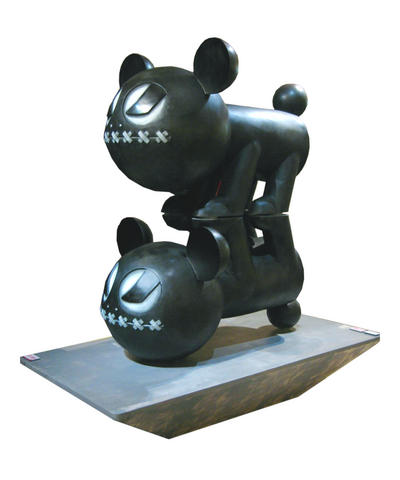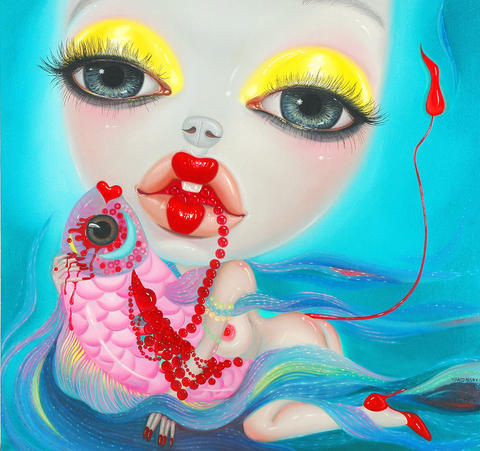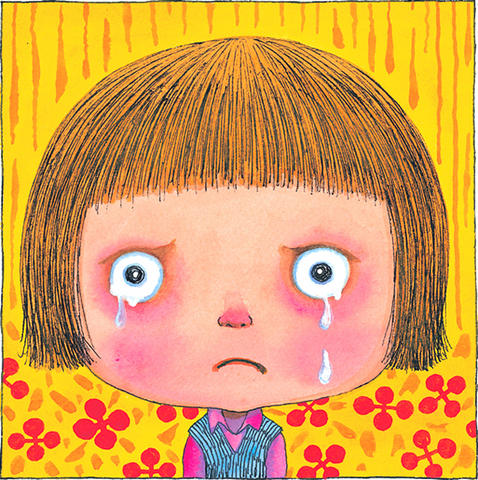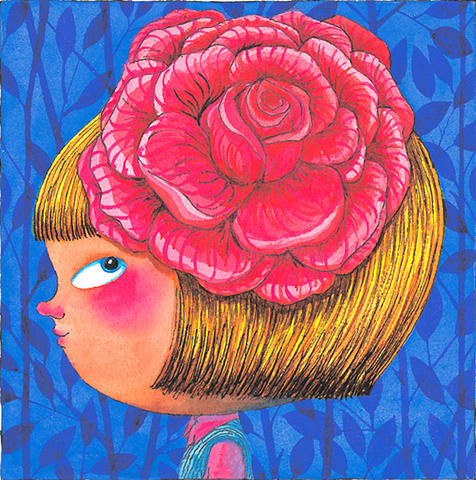Eddie Kang is obsessed with manga. An avid collector of the Japanese comics since he was a child, his creative world is dramatically influenced by animation and cartoons. But if you think that Kang is an otaku, a devotee of the geeky Japanese subculture of mostly men obsessed with anime, comic books and other forms of escapism, then think again.
With stylish hair, designer clothes and fluent English that betrays his eight years spent in the US - including four at the Rhode Island School of Design where he studied video, film and animation - the 27 year-old South Korean artist looks like he just walked off the set of a soap opera.
Kang is one of a new kind of Asian artist: computer savvy, working in pixels rather than pigment and using easy-to-understand visuals. He is one of 40 artists included in the animamix exhibit at the Sun Yat-sen Memorial Hall. "The most important thing I want to put in my work is storytelling," he said to the Taipei Times.

PHOTO: COURTESY OF METAPHYSICAL ART GALLERY
"Everyone has a desire to appreciate art, or visual language, but I think it's a matter of the form," he said. "If it's a form that people can easily understand, without reading a script, without reading my pre-sketched work, I think it's a form that communicates best with people."
Kang's ideas about art stand in stark contrast to the abstract styles in vogue during the 20th century, which produced works that left many confused over the meaning of a painting or sculpture.
That confusion was shared by many young Asian artists who were brought up on a diet of Japanese manga and anime. Their work has itself become an art movement called animamix.

PHOTO: COURTESY OF METAPHYSICAL ART GALLERY
Art critic and Shih Chien University professor Victoria Lu (陸蓉之) first coined the term animamix for a 2004 exhibit that she curated called Fiction.Love: Ultra New Visions in Contemporary Art at Taipei's Museum of Contemporary Art. She has since curated exhibits in Shanghai, Beijing and Singapore.
Lu says animamix art has four discernible characteristics: the worship of youth culture, images and objects that are rich in meaning, a new perspective on light influenced by computer technology and blurred distinctions between highbrow and lowbrow art into non-hierarchical art forms.
The last is particularly important because producing installations, paintings and sculptures that can be sold in the highbrow market are crucial to an artist's success.

PHOTO: COURTESY OF METAPHYSICAL ART GALLERY
"Fine artists can turn themselves into commercial artists if they want to," Kang said. "But [for] commercial artists it's really hard to develop their work into fine art. Andy Warhol is the exception to this rule."
Like Warhol, animamix artists take iconic images from popular culture, repackage them and sell them to the highest bidder. Takashi Murakami and Yoshitomo Nara are two examples. Murakami, with about 100 employees, recently sold a sculpture titled Mr Pointy to Christie's owner Francois Pinault for a reputed US$1.5 million, a testament to the growing popularity of his work on the international art market.
Unlike Warhol, however, animamix artists frequently mass-produce their works and market them as videos, mouse pads and more. Murakami has a whole line of plastic figurines that sell for about US$3. At the opening of the exhibition at the Sun Yat-sen Memorial Hall, South Korean artist Kwon Ki Soo was handing out rubber key chains and cell phone caddies of a character from his paintings.

PHOTO: COURTESY OF METAPHYSICAL ART GALLERY
Lu says that, though it remains a growing movement in the art market in Asia, animamix art still has had difficulty making inroads into the West.
"It is difficult to develop this kind of art in Europe or America because the [position of] modern … and conceptual art is too powerful. This is not so powerful a tradition in Asia," she said. Only with recent high-profile sales of Murakami's and Nara's art has that begun to change.
"[Dealers] now see Murakami [and] Nara selling well and are taking the artwork seriously. Before they thought [it was] childish. But for Asian countries, we … don't have the heavy modernist tradition weighing us down."
Ironically, Japan, the country that spawned animamix art and is getting the highest prices at the auction block is the country that has been least receptive to the art form. Hikaru Morioka, director of Gallery Unseal, says Japan's late arrival to the international art market coupled with a general lack of interest in local contemporary art has resulted in minimal interest in animamix compared to South Korea and China.
Contemporary art galleries in Japan always look to Europe or New York for artists, he said. This, however, has begun to change.
Four years ago there were practically no galleries in Tokyo dealing in Japanese contemporary art, he said. Today the number has grown to around 40 - though a figure Morioka still thinks is too low for such a large metropolitan center and the birthplace of manga and anime.
South Korea has a vibrant art scene due in part to a government law that makes it mandatory for most newly built buildings to devote a percentage of their budget to acquiring art. Hwaik Lee, who represents Kang, says the works in her gallery typically sell for between US$5,000 and US$50,000, with buyers coming from all over the world.
Morioka says collectors and dealers curious about China are stimulating interest. It's a sentiment echoed by Lu, though one she says has as much to do with the Japanese art market as it does with interest in China. "In Tokyo, the market is mostly for Japanese collectors. But Shanghai and Beijing will be a platform for all Asian art, not just Chinese art," Lu said, citing a group of Italian collectors who recently purchased Japanese works from galleries in China.
"There are many Korean galleries [with] branches in Beijing and Shanghai," she said. "Japan is following."
Animamix responds to and builds on previous movements. In this case, it builds on the formal ideas of modernism and escapes from the mystifying creations of abstract art. It also draws upon local pop culture.
"Animamix art will be as important for the 21st century as abstract art was for the 20th century," Lu said.
Be that as it may, for artists like Kang, it's simply representing what he sees around him in a style that is accessible to the public.

June 9 to June 15 A photo of two men riding trendy high-wheel Penny-Farthing bicycles past a Qing Dynasty gate aptly captures the essence of Taipei in 1897 — a newly colonized city on the cusp of great change. The Japanese began making significant modifications to the cityscape in 1899, tearing down Qing-era structures, widening boulevards and installing Western-style infrastructure and buildings. The photographer, Minosuke Imamura, only spent a year in Taiwan as a cartographer for the governor-general’s office, but he left behind a treasure trove of 130 images showing life at the onset of Japanese rule, spanning July 1897 to

One of the most important gripes that Taiwanese have about the Democratic Progressive Party (DPP) is that it has failed to deliver concretely on higher wages, housing prices and other bread-and-butter issues. The parallel complaint is that the DPP cares only about glamor issues, such as removing markers of Chinese Nationalist Party (KMT) colonialism by renaming them, or what the KMT codes as “de-Sinification.” Once again, as a critical election looms, the DPP is presenting evidence for that charge. The KMT was quick to jump on the recent proposal of the Ministry of the Interior (MOI) to rename roads that symbolize

On the evening of June 1, Control Yuan Secretary-General Lee Chun-yi (李俊俋) apologized and resigned in disgrace. His crime was instructing his driver to use a Control Yuan vehicle to transport his dog to a pet grooming salon. The Control Yuan is the government branch that investigates, audits and impeaches government officials for, among other things, misuse of government funds, so his misuse of a government vehicle was highly inappropriate. If this story were told to anyone living in the golden era of swaggering gangsters, flashy nouveau riche businessmen, and corrupt “black gold” politics of the 1980s and 1990s, they would have laughed.

In an interview posted online by United Daily News (UDN) on May 26, current Chinese Nationalist Party (KMT) Chairman Eric Chu (朱立倫) was asked about Taichung Mayor Lu Shiow-yen (盧秀燕) replacing him as party chair. Though not yet officially running, by the customs of Taiwan politics, Lu has been signalling she is both running for party chair and to be the party’s 2028 presidential candidate. She told an international media outlet that she was considering a run. She also gave a speech in Keelung on national priorities and foreign affairs. For details, see the May 23 edition of this column,